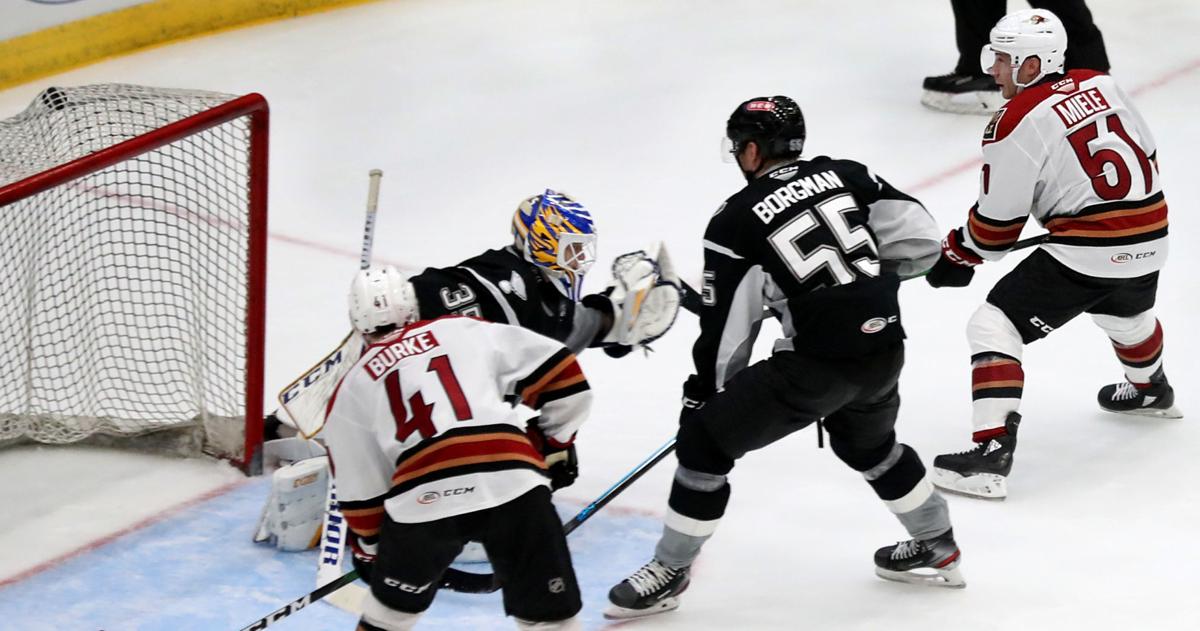When the Tucson Roadrunners outlasted the San Antonio Rampage in a ridiculous 15-round shootout earlier this month, it was déjà vu for team president Bob Hoffman.
“I felt like I’d been through this before,” said Hoffman, the Roadrunners’ business and off-ice administrative chief since 2016, with a laugh.
Hoffman had, in fact, been through this before – 15 years and about one week earlier.
While Tucson needed the longest shootout in team history to vanquish San Antonio, the Dec. 13 outing ended up just shy of the longest in American Hockey League lore. On Dec. 3, 2004, the Utah Grizzlies needed 16 rounds to defeat the Cleveland Barons.
Hoffman was on the radio call that night as the Grizzlies’ play-by-play man. Fast forward to Dec. 13 of this year; Hoffman said he could certainly relate to what Adrian Denny, the Roadrunners’ own play-by-play voice now in his second year in Tucson, must have seen that night.
“As a hockey broadcaster — and Adrian does this better than most — it’s about sharing the flow of the game. The game events don’t happen often,” Hoffman said. “A fight, a home-team goal, even a visiting team goal … those are the events. So, when you’re in a shootout, you’re figuring each one is the start of an event — and in my case it was 32 times. In Adrian’s case, 30.”
Denny couldn’t help but echo his boss in at least one respect: just laugh a bit and do what he can to explain from above the crazy scenario happening on the ice below.
“In San Antonio, for us, the two guys that had scored in shootouts this year, Lane Pederson and Beau Bennett, were done by the time we got to round 10,” Denny said. “So there are no stats to go with. It’s the first time for everybody involved.
“It was fun. It was a gong show,” he added. “It reminded me of one of those overtime playoff games, where you’d been there all night, waiting for something to happen. ‘OK, well, it’s in the hockey gods’ hands now.’”
While Denny and Hoffman admit to balancing fun with their own agony in the booth, both contend that the scenario down on the ice is all business for those involved.
For the Roadrunners (23-5-0-0), owners of the league’s best record when they return to action Saturday at night at Tucson Arena, the extra point earned in overtime or a shootout scenario could make all the difference. That would have been the case last season, when Tucson finished a single point away from earning a Calder Cup playoffs berth. Teams get one point for losing in overtime or beyond, and two for any kind of win. Tucson won seven of 15 post-regulation games in 2018-19. They went 6-5 in overtime but just 1-3 in shootouts.
So far in 2019-20, Tucson has won all five trips to overtime or beyond — including three in the 3-on-3 setting and two in shootouts. Only one other AHL team is yet to lose beyond regulation: the Manitoba Moose, with two overtimes wins, but no shootout experiences. The Hartford Wolf Pack have had the most games go beyond 60 minutes (11), with the Hershey Bears, Iowa Wild and Milwaukee Admirals at 10 apiece.
In an interesting twist of fate that proves how fickle overtime and shootouts can be, the team the Roadrunners’ defeated Dec. 13 in 15 rounds – San Antonio — has been past regulation eight times this season. The Rampage lost all eight, including five in overtime and three in shootouts.
Tucson coach Jay Varady that said the late success is a testament to his team’s depth.
“I think it’s an indication of players that can be impactful in different situations,” he said. “We’ve seen different players step up in 3-on-3, 4-on-4, and in shootouts. It’s an indication of the options we have in those areas.”
In the Roadrunners’ two shootouts — an already-long-enough nine-rounder in Tucson over the Stockton Heat Nov. 8, before the 15-round event a month later — goaltenders Adin Hill and Ivan Prosvetov stopped 8-of-9 and 14-of-15 opposition attempts, respectively. That’s in addition to holding tough before that, when the ice is much more open during the 3-on-3 skating offered in overtime.
“That just shows their competitiveness,” Varady said of Hill and Prosvetov. “They’re reading the play, reading the player coming down on them. But it also shows how they compete. Maybe they’re down and out, about to get beat, but able to shoot a pad out or throw a blocker up or get a stick on it. … That changes things.”
Varady and his players generally agree that while overtime includes significant strategy, there’s a bit of randomness to how a game will turn out once the shootout, generally slated for three rounds but open to as many necessary, starts. The ice is often chewed up after 25 consecutive minutes of full-ice skating, and round after round of action near the goal crease. That slows things down drastically, said Bennett, who scored the game-winner in the nine-round shootout against Stockton.
“Goalies were dialed, but the ice was really bad. You almost run out of moves trying to overthink it,” he said that night. “And once you get to the later rounds it takes a fluky goal like that to go in.”
But it’s not all random, Varady said. In addition to 3-on-3 situations, shootouts are something his team practices. Varady tends to try to play the percentages, noting which players have had the most prior success or are hot at the moment. Tucson defenseman Jordan Gross has been called on quite a bit in early rounds the last two seasons.
“It’s interesting: if you go back and look at different teams, sometimes the shootout guys aren’t the guys that you would suspect all the time … Grosser is one of those guys,” he said. “Sometimes there’s a couple hidden guys in there with some really good moves.”





